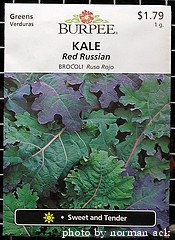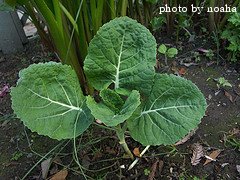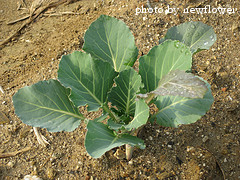Planting Kale
When planting kale, you can so the seeds directly into the garden in most cases. This method takes less time and you don't have to worry about hardening off seedlings, disturbing the roots, etc.. If you live in a cold climate and want a spring kale crop, you can start the seeds indoors and then transplant the seedlings into the garden when the soil becomes workable. Soil temperatures need to be at least 45 degrees F for the seeds to germinate. So, if it's colder than this when you want to plant, start the seeds indoors. Otherwise, sow the seeds into the garden.

Steps For Planting Kale
To sow the seeds directly into the garden, start by selecting a spot that gets at least 5-6 hours of direct sunlight. Go about tilling the area to a depth of at least 6 inches. Kale plants don't have deep roots, but they do need soil to drain pretty well. If your soil is a bit acidic, add some crushed limestone or egg shells to bring up the pH level. In our own garden, we scatter pulverized limestone, because it breaks down the quickest.
After tilling the soil, get an idea of where you want the rows.
When planting kale, you'll sow a seed every 6 inches or so and space
the rows 2 feet apart. When you know where your rows will be, spread
out a thin layer of compost or well-rotted manure if you've got it.
This will help with moisture management and will also give the plants
plenty of nutrients after they germinate. At this point, it's not a good idea to add fresh manure and it can mess up the pH in your soil.
After applying the
compost, wait at least a day and then use a hoe to create rows. The
seed will be planted just 1/2 inch deep so don't disturb the soil too
much. Sow the kale seeds every 6 inches or so and cover with a 1/2 inch
layer of fine soil. After planting kale seeds, water them in with a
quick spray from the hose. When the seedlings emerge and are a few
inches tall, thin to one plant every foot or so to give the plants
plenty of room.
If you find that the germination rate of your kale seeds isn't very consistent and you end up with crowded sections and empty sections of a row, you can always transplant the seedlings from the crowded area into the empty area. Wait until the seedlings are a couple of inches tall and use a trowel to carefully dig them up. Try to get all of the root ball by digging up a 3"x3" area around the seedling. However, also be mindful to not disturb the root systems of nearby seedlings. Take the seedling and plant it in a similar-sized hole that you dig in the empty part of the row.
If you're starting the seeds indoors, start about 6 weeks before you want to transplant them into your garden. Fill a flat with top soil. A flat is just a tray of compartments to start seeds in. Add a seed to each compartment and cover with 1/2 inch of soil. Place the flats in a sunny spot and keep the soil moist by misting them with water every other day. When the seedlings are 4 inches tall and have at least 4 true leaves, they are ready for transplant.

The last week or so before transplanting kale, you
need to harden off the seedlings. Basically, you just need to get them
used to the outside temperatures, which are probably cooler than what
they've been used to inside. Place the plants outside for a couple of
hours a day to start off. Increase the time they spend outside by a
couple of hours each day until you are ready to transplant them.
To
transplant the kale seedlings, dig a hole every 12 inches or so in the
row and space rows 2 feet apart. The holes need to be just deep enough
to bury the seedling up the base of the bottom leaves. Carefully remove
them from the container, keeping as much of the root ball intact as
possible, and place the seedlings in the hole. Backfill the hole with
dirt until the bottom of the lowest leaves are even with the surface of
the soil. Tamp the soil down gently around the plants and then water
them in immediately. It should take only a couple of days for the
seedlings to get established.
Now that you're done planting kale, it's time to think about fertilizing and watering your crop.

Click here for information about fertilizing and watering kale
Click here to learn about harvesting kale
Click here for information on different kale varieties
Click here for some of our favorite kale recipes
Click here to move from our Planting Kale page to our Growing Kale main page